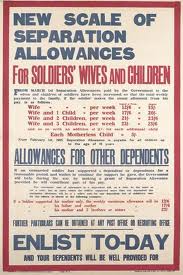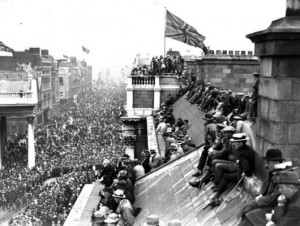Dublin and Cork during the First World War

This is a conversation between historians John Borgonovo and Padraig Yeates on two Irish cities, Dublin and Cork during the First World War. Originally recorded for Near FM’s History Show.
The First World War was a turning point in European and World history and Ireland was no different. Over 200,000 Irishmen served in British forces during the war and around 30,000 died in it. Moreover, the war came at a time when Irish autonomy or Home Rule was being negotiated and resisted by unionists – rival nationalist and unionist paramilitary groups had been formed. Though the promise of both Home Rule nationalists and unionists to support the British war effort appeared at first to have staved off internal conflict, in the long term the demands of the war, coupled with the nationalist insurrection in Dublin in 1916, touched off nationalist revolution.
There was however, far more to Ireland’s experience of the Great War than that. Both Yeates and Borgonovo have written books on the urban experience of the war and delve deeply into the effects the conflict had on the ground. The British Army was initially able to tap into a long tradition of urban military service for recruitment in 1914. The urban poor, unlike their rural counterparts looked on soldiering as a respectable way out of poverty. As the war went on, more and more men figured out that wartime service in for instance the engineering corps or the RAF could be used to learn a trade without having to serve in the front line.
At home their dependents, the ‘separation women’ (so called because they received the Separation Allowance while their husbands were away) enjoyed a brief spike in their standard of living and were much despised by many parties; nationalists because they were taking the ‘King’s shilling’, by the middle classes more generally because they were allegedly drinking away their new-found (relative) wealth. (Fionnuala Walsh also discusses this issue here).
The war brought with it mixed economic effects, Yeates and Borgonovo tell us. On the plus side, the war economy produced new jobs manufacturing food, uniforms and weapons, but on the downside the shortage of food and other items meant prices rocketed. Though as Yeates tells us, malnutrition rates in Dublin actually deceased during the war, it nevertheless caused considerable hardship too, to the extent that serious people were worried about a ‘second famine’ in the winter of 1917-18.

The decisive impact the war had on Ireland however was the conscription crisis of April 1918. British government attempts to impose mandatory military service on Ireland were met with huge resistance – including a one day general strike – and were ultimately defeated; a series of events that Borgonovo in particular argues was the beginning of the end of British rule in most of Ireland.
The southern unionist community in particular emerged as the big Irish losers in the War. Their young men had suffered disproportionate casualties at the front but their desire to maintain the connection with Britain also lay in tatters if not by 1918, then certainly by 1922.
Both Yeates and Borgonovo, though cognisant of the importance of the Great War in Irish European and world history, are wary of commemoration of mythologising of the conflict. As Yeates puts it, ‘the ruling class in Europe got itself into a mess that it could not sort out and everyone else suffered’. Plus ca change plus ca meme chose.